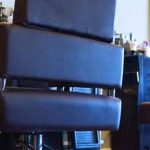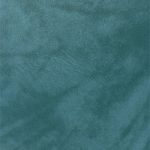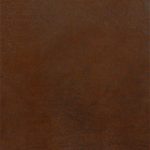
Vinyl
PVC
Urethane
Bonded Leather
Marine
Backed
Nonbacked
OY VE! What the hey! So how many licks does it take to get to the center of this Tootsie Roll?
One…two…a whoo whoo…three
The Process
Disclaimer: The following section uses way too many $12 words.
To make vinyl, a chemical polymer (big word for a bonding agent, not to be confused with 007) called a plasticizer is added to polyvinyl chloride, a.k.a. PVC which is made into upholstery material. The resulting fabric may or may not have a fabric backing. Different coatings or treatments, specialty backings or chemicals can also be added during the manufacturing process to change how the application of different fabrics.
Now, before you go all goofy eyed on me when we dive into talking about the virtues of vinyl, let’s talk about what vinyl is and why it’s relative to the conversation of fabric. I hear your wheels turning. You’re like, vinyl is plastic, it’s not legit fabric, man. It’s gonna leach out on your skin and you’ll turn into Gumby or Pokey!
Relax. But to your concern, fine. Let briefly discuss the less than virtuous side of vinyl.
Let’s begin with plasticizers . Plasticizers are chemicals, that when added during the production of vinyl, allow it to remain flexible. Now there are good plasticizers and promiscuous ones that have been around a few times. The ones you’d bring home to Mama are called virgin. It simply means that it’s not recycled plastic. The naughty ones have seen some action, meaning they contain recycled plastic that contains a variety of ingredients that are potentially harmful.When those materials are recycled again, such as when your bar stool becomes curb appeal, you introduce unwanted substances into the environment. Don’t get me wrong, recycling plastic is a good thing, a very good thing to practice. But you can only be a virgin once. After that, well the waters can get muddy…

So if you don’t know where it’s been, use protection between you and the chair seat. Not really, but it’s a good illustration! You won’t catch anything, I promise; but if your footprint matters, then look for the purity promise and choose to only purchase virgin vinyl
Glad we explored that. Now, with that being said, all vinyl is not evil, even the naughty stuff. It has a purpose and a place in the design industry. So let’s go there!
Expanded (Commercial or Contract Grade)
 [1]When the application calls for strength, durability, tight construction, expanded vinyl is what you need. Fabric backed, it features additional strength and stretch that allows the installer to pull on the fabric around corners and across a frame without tearing or distorting. Because it is fabric backed, it will require a little more work fabricating multiple layers. I recommend a triangle point leather needle, 16-18 depending on your machine and heavy duty thread. Lighten up the pressure on the presser foot as well so you don’t dent the fabric. I’d also recommend doing a saddle stitch on every seam. We won’t discuss that here. Lots of great tutorials online.
[1]When the application calls for strength, durability, tight construction, expanded vinyl is what you need. Fabric backed, it features additional strength and stretch that allows the installer to pull on the fabric around corners and across a frame without tearing or distorting. Because it is fabric backed, it will require a little more work fabricating multiple layers. I recommend a triangle point leather needle, 16-18 depending on your machine and heavy duty thread. Lighten up the pressure on the presser foot as well so you don’t dent the fabric. I’d also recommend doing a saddle stitch on every seam. We won’t discuss that here. Lots of great tutorials online.
So if your project needs serious torking, EV is your choice!
Marine Grade Expanded
 [2]So we just looked at EV or expanded vinyl. What is Marine Grade EV? Exactly what you think it is. Marine Grade vinyl is for surfaces that will be outdoors, in a wet environment, exposed to sunlight, boat seats, you get the idea. It has all the features and benefits of regular EV, but with the added benefit that it’s coated with UV protectant, flame retardant coating, anti-fungal, anti-mildow/mold coatings. Additionally, BFS MGEV (let’s all just drown in a sea of alphabet soup here) is made of virgin PVC. Since we’ve covered that subject…moving on. But, let me just quickly add that an valuable feature of virgin PVC is its longevity. Because it’s all new material, it hasn’t been subjected to use and isn’t degraded in any way. MGEV can be used exactly the same way as EV. In some ways, it’s a better choice because you have the extra coatings. Let’s be real, you’re probably are using vinyl for a reason. If you have kids that spill or a basement that gets dampish, you’ll want the anti-fungal/mold coating. When you don’t need a decorator edge for your look and a solid works, go with MGEV
[2]So we just looked at EV or expanded vinyl. What is Marine Grade EV? Exactly what you think it is. Marine Grade vinyl is for surfaces that will be outdoors, in a wet environment, exposed to sunlight, boat seats, you get the idea. It has all the features and benefits of regular EV, but with the added benefit that it’s coated with UV protectant, flame retardant coating, anti-fungal, anti-mildow/mold coatings. Additionally, BFS MGEV (let’s all just drown in a sea of alphabet soup here) is made of virgin PVC. Since we’ve covered that subject…moving on. But, let me just quickly add that an valuable feature of virgin PVC is its longevity. Because it’s all new material, it hasn’t been subjected to use and isn’t degraded in any way. MGEV can be used exactly the same way as EV. In some ways, it’s a better choice because you have the extra coatings. Let’s be real, you’re probably are using vinyl for a reason. If you have kids that spill or a basement that gets dampish, you’ll want the anti-fungal/mold coating. When you don’t need a decorator edge for your look and a solid works, go with MGEV
Non-expanded
Also known as economy grade, NEV is suitable for applications where strength and durability are no a concern. If you look at the back, the first thing you’ll notice is the lack of a backing. Whatever backing there is will be cloth more than likely, flannel, linen, cheesecloth or even polyfill. The fabric itself is thin, maybe 1/16 inch at most. When you turn nonexpanded vinyl over, you typically find a backing made from cloth. Best uses, occasional chairs, purses, decorative trim, anything that you want the look, minus the cost. If you choose NEV for saving money on a piece that will be used often, expect it to need replacing sooner than you might light.
Faux Leather
 [4]
[4]
As long as we’re discussing vinyl, we have to discuss faux or fake leather. Some people call it pleather or vegan leather. Either way, tomato tamato, it’s still a vinyl product. As with any vinyl product, look for expanded or non-expanded based on your needs.
Bonded Leather
Whaaaat??? One of the most confusing things is this product known as bonded leather. The problem is that, in the leather industry, by legal definition, it can be called real leather, genuine leather, or the $12 version, vero curio which literally means “real leather“, because it made from pieces of leather. But just like in the building industry, press board or plywood can be called “wood” or all wood, it’s not totally a legit description. It’s not vinyl, it’s not leather, it’s Frankenfabric. And remember, Frank really didn’t mean any harm. He was just misunderstood. So put away your pitchforks.
Unlike fabric that comes in long sheets of a consistent width and thickness, leather is an animal hide; and animals do not grow into perfect squares and rectangles (or polygons of any sort). They are irregular, and as such, to produce a hide for upholstery use, a tanner must work with the shape given working around legs and necks and all that gory stuff. It’s also a costly product due to the labor needed to fabricate hides either as is, or by stitching them together to form sheets.
In the process, there is also a lot of waste. So just like you might buy bits and pieces bulk bacon (well, I do at least!), fabricators use the bits and cutoff pieces to make bonded leather. The scraps are ground down into a mulch, then kind of like making paper, only not with water, so more like paper maché, the mulch is mixed with a bonding agent like polyurethane to form a fabric. And like faux leather, it can also be expanded or not. There is a place and a purpose for bonded leather. A high quality product can provide the look and feel of real leather and even fool your neighbors (or an unsuspecting consumer being sold a bill of goods…). Poor quality bonded leather will peel, so as with any fabric, you will get what you pay for.
So be cautious. BFS only offers faux and bonded leather, and we’ll not try to fool ya by calling it gen-you-wine.
Vinyl has a place. I mean, if it weren’t for vinyl, it wouldn’t be any fun riding in a hot car with shorts, or sliding into a booth at your favorite diner!
Sew ‘n piece my friends!

